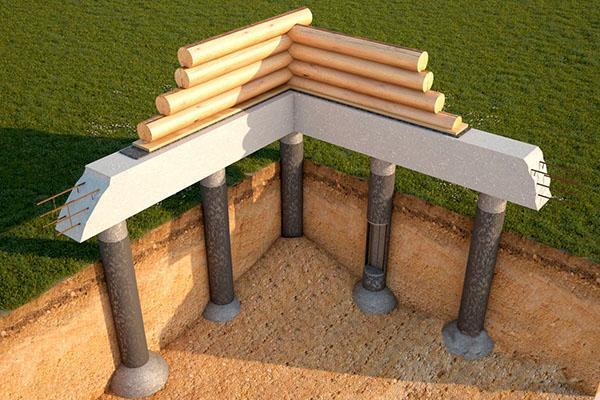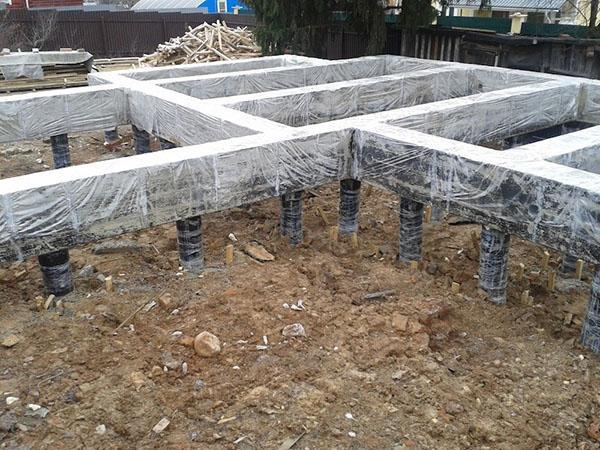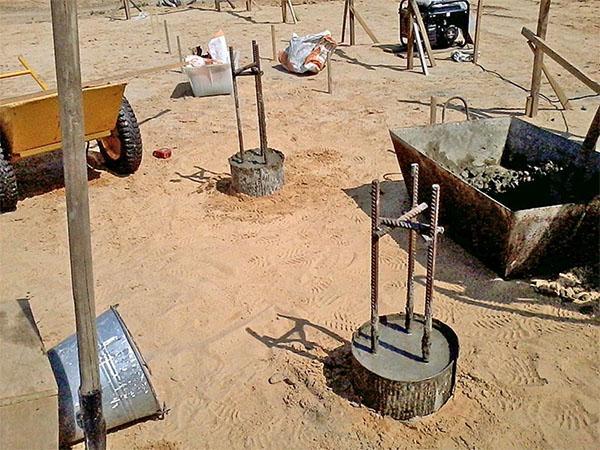What is the TISE foundation
 When it comes to building a house, the first thing to think about is the type of foundation. In recent years, the foundation of TISE has become very popular. This is due to the fact that the technology has a high bearing capacity, which is significantly higher than required.
When it comes to building a house, the first thing to think about is the type of foundation. In recent years, the foundation of TISE has become very popular. This is due to the fact that the technology has a high bearing capacity, which is significantly higher than required.
Scope of the foundation for TISE technology

- The possibility of installing a foundation with a high bearing capacity and at the same time with a minimum amount of earthwork, significantly reduces labor costs and the impact on the environment of the adjacent territory.
- Reducing the sensitivity of the structure of the building to all kinds of soil vibrations from passing trains or trams.
- Piles using TISE technology protect the structure of the structure from destruction during the expansion of the soil in severe frosts.
The bottom point usually becomes the main one when choosing the type of foundation.
In general, this technology is not much different from all kinds of other types of pile supporting structures. The main difference lies in the TISE pillars themselves. The pile looks like a screw turned upside down. The lower part has a hemispherical shape, the radius of which is twice the pillar itself.
 Unlike other types of supports, piles are poured with concrete directly in the ground using TISE technology. This type of installation greatly simplifies the transportation of the elements, as well as their installation. However, for proper erection, it is necessary to place the support of the pillar deeper than the level of soil freezing. Usually, a well is drilled with a depth of 1.50 - 2.50 m, but in the northern regions it will be necessary to locate the base significantly deeper. There are not many reasons for drilling this depth, but still they are:
Unlike other types of supports, piles are poured with concrete directly in the ground using TISE technology. This type of installation greatly simplifies the transportation of the elements, as well as their installation. However, for proper erection, it is necessary to place the support of the pillar deeper than the level of soil freezing. Usually, a well is drilled with a depth of 1.50 - 2.50 m, but in the northern regions it will be necessary to locate the base significantly deeper. There are not many reasons for drilling this depth, but still they are:
- the concrete body of the structure itself provokes deeper freezing of the soil.
- the location of the base at a depth is noticeably below the freezing level, where the average temperature is +3aboutC, to some extent, they heat up a part of the TISE pile, preventing it from thermal damage.
Do-it-yourself TISE foundation
Despite the high reliability of the TISE foundation, its installation implies strict adherence to some of the nuances of construction. This technology, in comparison with the simplest tape version of the foundation, is very complex and errors during construction are unacceptable. Otherwise, their elimination can be quite expensive. Based on such capriciousness of the technology, before starting the installation, it is necessary to make a detailed calculation of the TISE foundation.
Drawing up an individual calculation
 There are many different methodologies and practical recommendations that are based on the precise determination of soil properties and method definition. foundation reinforcement... However, it should be understood that without engineering skills it is better to abandon this method of calculation. Since it is very easy to make a mistake, and in the future it will be very costly to get rid of its consequences.
There are many different methodologies and practical recommendations that are based on the precise determination of soil properties and method definition. foundation reinforcement... However, it should be understood that without engineering skills it is better to abandon this method of calculation. Since it is very easy to make a mistake, and in the future it will be very costly to get rid of its consequences.
It is preferable to determine the number of piles and the step between them in the following way:
- Based on the sketch of the building, its dimensions, the material of the walls and floors, as well as the total mass of the roof, its mass is determined. To the resulting number, add the weight of all furniture, equipment, the mass of the maximum layer of snow on the roof, and the estimated additional load, usually about a ton.
- Having drilled several points of the pit to a meter depth, the bearing capacity of the soil on the construction site is determined. For example, the resistance of clay soil is on average 6 kg / m2, thus, choosing a pile with a diameter of 500 mm, its bearing capacity will be equal to 11.7 tons.
- After that, the approximate mass of the structure is divided by the standard for the individual base of the TISE pillar. The resulting number is the number of supports for the structure, and dividing the length of the entire foundation by it, the step distance between the piles is obtained.
| Soil type | Soil resistance, kg / m2 | Bearing capacity of the support, T | ||
| 250mm | 500mm | 600mm | ||
| Coarse sand | 6,0 | 3,0 | 11,76 | 17,0 |
| Medium sand | 5,0 | 2,5 | 9,8 | 14,0 |
| Fine sand | 5,0 | 2,5 | 11,76 | 8,4 |
| Dusty sand | 3,0 | 1,5 | 5,88 | 5,6 |
| Sandy loam | 3,0 | 1,5 | 5,88 | 8,4 |
| Loam | 3,0 | 1,5 | 5,88 | 8,4 |
| Clay | 6,0 | 3,0 | 11,76 | 17,0 |
For ease of determining the pitch between the supports, it should be understood that its distance directly depends on the thickness of the column. For a 30-centimeter section, it is quite possible to take a step of 1.5 m.
When compiling the calculation, you can also use special software, which will most accurately determine the required number of TISE piles. Usually, the help of software is resorted to if the budget is too limited or there is a need to draw up detailed documentation for the customer.
Preparatory work for the installation of TISE piles
 The most difficult task in the construction of this type of foundation is drilling pile wells. For this work, a special foundation drill TISE, "Tise-F", is provided. It is quite difficult to drill enough holes alone, especially if the soil is very dense.
The most difficult task in the construction of this type of foundation is drilling pile wells. For this work, a special foundation drill TISE, "Tise-F", is provided. It is quite difficult to drill enough holes alone, especially if the soil is very dense.
Before driving in pits, it is necessary to mark the future foundation on the territory and highlight the centers of future wells. The soil that comes out to the surface should be pulled onto a tarp or thrown into a wheelbarrow, and periodically taken as far as possible from the construction site.
Builders with significant experience in the construction of the TISE pile foundation recommend drilling in two stages:
- First of all, all well centers are drilled to a depth of approximately 85% of the planned one. This will be somewhat easier to do without the use of a side shear attachment.
- After that, two buckets of water are poured into each drilled well to soften the soil. An hour later, you can start forming a cavity under the TISE support using a shearing nozzle.
During drilling, a strict vertical should be observed, in the future this will help to correctly position the reinforcement.
If the radius of the base is too large, it is quite difficult to select all the soil, but nevertheless it must be done. During operation, you can periodically add water and combine the rotation of the device with pushing, it is only important that the side blade makes a uniform cut.
TISE pile foundation casting
 Before starting the shaping of the piles themselves, two more work should be done first: make a waterproofing layer and install reinforcement. Waterproofing of pillars is necessary in order to provide frost resistance of the structure in conditions of high humidity. As for the installation of the reinforcement, it is worth understanding how important its correct installation is for the strength of the entire foundation.
Before starting the shaping of the piles themselves, two more work should be done first: make a waterproofing layer and install reinforcement. Waterproofing of pillars is necessary in order to provide frost resistance of the structure in conditions of high humidity. As for the installation of the reinforcement, it is worth understanding how important its correct installation is for the strength of the entire foundation.
Roofing material is best suited as waterproofing. Due to the density of the material, it is able not only to protect the pillars from moisture, but also to become a good formwork for TISE piles. With a sheet width of 1 m, it is cut to length, the size of the depth of the well and additionally taking into account the required height to the bottom of the future base of the structure. The workpiece is rolled up into a pipe with a diameter equal to the dimensions of the well.After lowering, the protruding part is additionally reinforced with spacers.
In order to avoid difficulties due to the discrepancy between the heights of the pillars, it is better to initially add 5 cm to the height of the protruding part of the future pile.
Reinforcement of the TISE foundation is generally not complicated. However, it is better to make the reinforcement cage in advance, since it is very difficult to correctly position all the rods individually in the well. A kind of cylinder is created from the material with a step of transverse reinforcement of about 30 cm. For this purpose, reinforcement with a thickness of 12 mm is most often used, which is connected with each other by a thicker metal. The upper ends of the reinforcement protrude above the formwork relative to the height of the grillage.
Before pouring, the reinforcement frame should be leveled so that the protruding bars are strictly perpendicular to the future base.
Pouring of concrete for a bored TISE pile is most often carried out through a sleeve. When half the depth of the well is flooded, it is necessary to casing the mud. For this, a scrap of sufficient size is suitable, with which concrete is rammed to fill all the voids formed in the area of the pile heel.
Assembling the foundation
 When the work on the erection of the supports is completed, you can start assembling the TISE pile foundation foundation. Installation of the carrier tape of the grillage is carried out using a similar technology for installing the strip foundation.
When the work on the erection of the supports is completed, you can start assembling the TISE pile foundation foundation. Installation of the carrier tape of the grillage is carried out using a similar technology for installing the strip foundation.
Formwork is created for laying further material along all the piles, and sand is scattered and compacted between them. It is needed to form the support of the formwork bottom plate. It is important to align the horizontal line of the entire wooden structure in order for the liquid mass concrete did not flow to one side.
Further, the reinforcement is laid along all the channels of the formwork. In this case, the structure can no longer be welded to each other, but simply rigidly fixed with a thin wire.
During the pouring of concrete, anchor bolts are fixed in the body of the future foundation. They will be needed for the further construction of the walls. After the completion of the installation work, the entire structure is covered with a film. At least two weeks are expected before future construction work.
At the end of the topic, it should be noted that the main disadvantage of the TISE foundation technology is the complexity of its construction. Also, the need for a detailed calculation of the load and taking into account the characteristics of the soil before starting work.